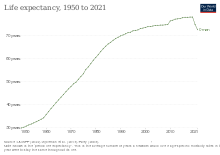| This article needs additional citations for verification. Please help improve this article by adding citations to reliable sources. Unsourced material may be challenged and removed. Find sources: "Healthcare in Oman" – news · newspapers · books · scholar · JSTOR (January 2021) (Learn how and when to remove this message) |
Omani nationals have free access to the country's public healthcare, though expatriates typically seek medical care in private sector clinics and hospitals. Generally, the standard of care in the public sector is high for a middle-income country. Oman now has very low rate of once common communicable diseases such as measles and typhoid. Due to rapidly increasing incomes and changing lifestyles and diet, the levels of non-communicable diseases such as cardiovascular disease and diabetes are an increasing problem.
The hospitals in Oman generally provide a high quality of health care. Most of the largest and most advanced hospitals and health centres are located in Muscat, such as the Royal Hospital of Oman and the Sultan Qaboos University Hospital.

Though the Omanis have a high life expectancy of 73.8 the nation's medical industry can not be compared to other more developed countries. Still the government is trying to develop this sector and encourage students to study medicine. Although a sizeable portion of the healthcare workforce is foreign born, due to an aggressive government policy of Omanization, this is beginning to change. The country now has an accredited medical university and many Omani doctors have obtained their medical training in countries such as Australia, Canada, the United Kingdom and the United States.
Health Technology Assessment (HTA) Implementation in Oman
Integrating Health Technology Assessment (HTA) aims to improve healthcare resource allocation. HTA is a multidisciplinary process that evaluates the benefits and value of health technologies to support decision-making and promote efficient resource allocation. A recent study developed a roadmap for HTA implementation, highlighting the need for training, sustainable funding, and a structured organizational framework
Recommendations
The study outlined a set of recommendations to bridge the gap between the current and desired HTA status in Oman:
Enhance Capacity Building
Oman should focus on developing comprehensive training programs in the short term, with plans to establish graduate programs in the long term. Short courses and workshops should be maintained to provide ongoing education for current professionals. Introducing undergraduate courses in health economics for medical and pharmacy students will help foster a foundational understanding of HTA.
Increase HTA Funding
Funding for HTA should primarily come from the Ministry of Health, with additional contributions from the private sector. This balanced funding model will ensure the sustainability of the HTA process and support comprehensive evaluations.
Establish a Formal HTA Structure
A national HTA unit will be established under the Ministry of Health to coordinate and oversee all HTA activities, ensuring consistency and efficiency in the evaluation process. Initially, this unit will focus on high-budget pharmaceuticals and later expand to include medical devices, surgical interventions, and prevention programs.
Expand HTA Scope
Expanding the scope of HTA is necessary to include various health technologies such as pharmaceuticals, medical devices, prevention programs, and surgical interventions. Revising existing policies using HTA will ensure they reflect current evidence and best practices. This expansion should be phased, prioritizing high-impact areas initially and gradually extending to other technologies over time.
Implement Decision Criteria
Implementing decision criteria involves adopting explicit soft thresholds for cost-effectiveness and piloting the Multi-Criteria Decision Analysis (MCDA) framework. This will systematically evaluate multiple factors including cost-effectiveness, therapeutic value, and budget impact in the decision-making process. Ensure Quality and Transparency Ensuring quality and transparency requires developing methodological guidelines for HTA to standardize the appraisal process and improve the quality of assessments. Publishing HTA reports, critical appraisals, and recommendations will make the process more transparent and foster stakeholder trust. Setting clear timelines for HTA submissions and recommendations will ensure timely and predictable decision-making.
Utilize Local Data
Utilizing local data is essential and this can be achieved by mandating the inclusion of local data in HTA to ensure relevance and accuracy in the Omani context. Developing robust databases such as patient registries and payer databases will provide high-quality, accessible data for HTA. Establishing partnerships with healthcare providers and insurers will enhance data sharing and access for HTA purposes.
Foster International Collaboration
Fostering international collaboration involves participating in and hosting HTA training programs and working with regional bodies like the Gulf Cooperation Council (GCC). This will help leverage global expertise and avoid duplicative efforts. Organizing and participating in international HTA courses and workshops will build local expertise and keep professionals updated on global HTA advancements.
See also
References
- Moeness M Alshishtawy (April 17, 2010). "Four Decades of Progress Evolution of the health system in Oman". Sultan Qaboos University Medical Journal. 10 (1): 12–22. PMC 3074664. PMID 21509077.
- Fasseeh, A. N., Saragih, S. M., Hayek, N., Brodovska, S., Ismail, A., Elshalakani, A., ... & Kalo, Z. (2022). Impact of health technology assessment implementation with a special focus on middle-income countries. Health Policy and Technology, 11(4), 100688.
- Kelley, L. T., Egan, R., Stockley, D., & Johnson, A. P. (2018). Evaluating multi-criteria decision-making in health technology assessment. Health Policy and Technology, 7(3), 310-317.
- Mueller, D., Tivey, D. and Croce, D. (2017), “Health-technology assessment: its role in strengthening health systems in developing countries”, Southern African Journal of Public Health, Vol. 2, pp. 6-11.
- Al Rashdi, I., Al Balushi, S., Al Shuaili, A., Al Rashdi, S., Ibrahim Al Bulushi, N., Ibrahim Al Kindi, A., ... & Kaló, Z. (2024). A roadmap towards implementing health technology assessment in Oman. Journal of Health Organization and Management, 38(9), 241-257.
| Oman articles | |||||
|---|---|---|---|---|---|
| History |  | ||||
| Geography | |||||
| Politics |
| ||||
| Economy | |||||
| Society | |||||